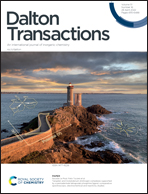Reversible mechanochromic studies on AIE-inspired smart materials and their applications in HCHO sensing†
Abstract
Smart fluorescent materials that respond to external stimuli have received more and more attention because of their excellent optical properties in the field of anti-counterfeiting, information security and fluorescence sensing. Herein, we reported a new stimulus-responsive material, {[Zn4(TCPE)(HTCPE)(DMA)3(OH)(H2O)2]·2DMA·2H2O}n (HPU-21), which showed a series of fluorescence changes under the influence of temperature, pressure and solvents. Combined with the temperature-dependent fluorescence, 1H NMR and 13C NMR spectra, TEM and powder X-ray diffraction results, the fluorescence transformation was mainly attributed to the changes in the twisted ethyl core and the multiple rotational phenyl rings, as well as the aggregation degree. Based on these findings, we designed an adjustable formaldehyde probe with excellent performance. The detection limit of formaldehyde in aqueous solutions is calculated as 35 ppb, which is much lower than the concentration that is harmful to health (20 ppm). The extremely high sensitivity to formaldehyde makes it have potential application prospects in practical formaldehyde detection.



 Please wait while we load your content...
Please wait while we load your content...